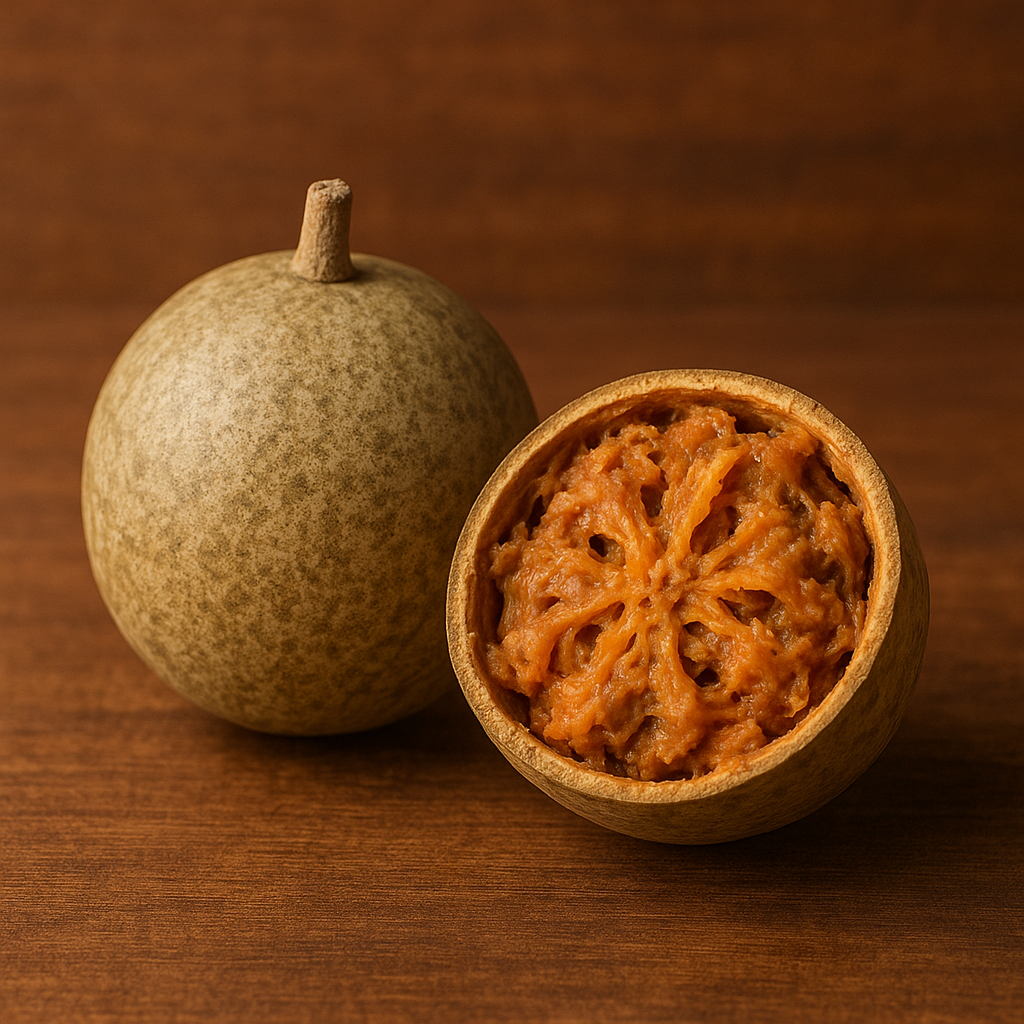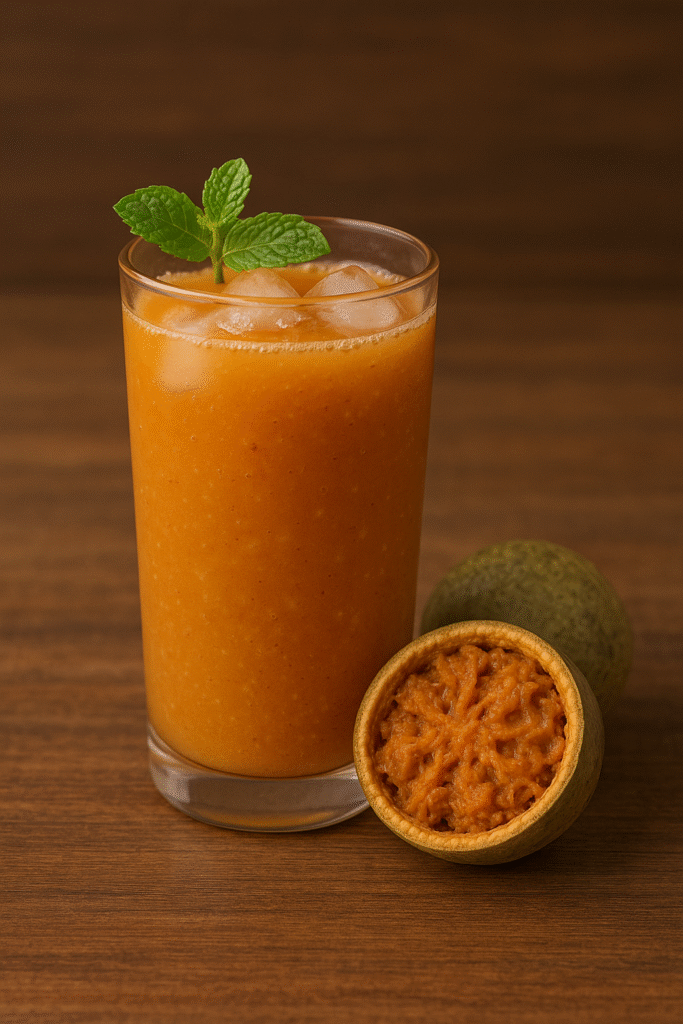
Table of Contents
ToggleWood Apple (Bael)
Wood apple, also known as Bael, Aegle marmelos, Bel fruit, or Bili tree fruit, is a traditional fruit native to India and other parts of Southeast Asia. Recognized for its hard, woody shell and aromatic pulp, the wood apple is both a revered fruit in Ayurveda and a cherished ingredient in regional cuisines. Bael is particularly popular during the summer months and religious occasions in India, where it’s offered in temples and consumed for its health-boosting properties.
The fruit is typically round or oval, with a rough, hard shell that ranges from green to pale brown as it ripens. Inside, it contains a fragrant, sticky pulp that is yellowish-orange in color, embedded with seeds and fibrous strands. Its taste is a mix of sweet, tangy, and slightly astringent, making it a refreshing treat when blended with sugar or jaggery.
Nutritional Benefits of Wood Apple
Wood apple is often called a “superfruit” due to its extensive health benefits. Here’s what makes it nutritionally rich:
Rich in fiber: Excellent for digestion and relieves constipation.
High in antioxidants: Boosts immunity and helps combat oxidative stress.
Loaded with vitamins and minerals: Especially Vitamin C, Vitamin A, Calcium, Phosphorus, and Potassium.
Antibacterial and antifungal properties: Helpful in treating infections and maintaining gut health.
Cooling effects: Ideal for summer as it helps reduce body heat and prevents sunstrokes.
Medicinal Uses in Ayurveda
Bael is considered a holy and medicinal fruit in Ayurveda. Some traditional uses include:
Treating digestive disorders such as diarrhea, dysentery, and indigestion.
Cleansing the liver and promoting healthy bowel movements.
Reducing inflammation in the gut lining.
Managing diabetes by regulating blood sugar levels.
Boosting respiratory health due to its anti-inflammatory properties.
The roots, leaves, and fruit pulp of bael are used in various Ayurvedic formulations.
Culinary Uses of Wood Apple
Though it may look unassuming from the outside, wood apple is a versatile culinary ingredient. It is used to make:
Wood apple sherbet or juice
Chutneys and jams
Bael candy
Bael murabba (preserve)
Bael laddoo or sweet balls
Fermented drinks and syrups
Among these, wood apple juice (bael sherbet) is the most popular and refreshing preparation.
Wood Apple Sherbet Recipe (Bael Juice)
Ingredients:
1 medium-sized ripe wood apple
2–3 tablespoons of jaggery powder or sugar (adjust to taste)
2 cups of cold water
A pinch of black salt (optional)
A few drops of lemon juice (optional, for tanginess)
Mint leaves for garnish (optional)
Ice cubes (optional)
Step-by-Step Recipe:
1. Choose a Ripe Wood Apple:
A ripe wood apple has a mildly sweet fragrance and turns from green to brown. Tap it gently – if it sounds hollow, it’s ready.
2. Break Open the Shell:
Use a heavy spoon or a small hammer to crack the hard shell. Be cautious – the shell is very tough. Scoop out the soft, sticky pulp into a bowl using a spoon.
3. Soak the Pulp:
Add 2 cups of cold water to the pulp. Let it soak for 10–15 minutes to soften the fibers. This will help in easy blending.
4. Mash and Strain:
Use your fingers or a spoon to mash the pulp well into the water. Once done, strain the mixture through a sieve or muslin cloth to remove seeds and fibers. Discard the residue.
5. Add Sweetener and Flavor:
Add jaggery or sugar to the strained juice. Mix until it dissolves completely. Add black salt and lemon juice for extra flavor if desired.
6. Chill and Serve:
Pour the juice into glasses. Add ice cubes and garnish with mint leaves. Serve immediately for a refreshing and cooling drink.
Serving Size:
Serves: 2–3 people
Preparation Time: 15–20 minutes
Best served: Chilled, especially in summer
Variations of Bael Juice
Mint Bael Juice: Blend mint leaves with the pulp before straining for a cooling herbaceous twist.
Spiced Bael Juice: Add roasted cumin powder and a pinch of chaat masala for a savory Indian touch.
Bael Smoothie: Blend the pulp with yogurt, honey, and a banana for a nutrient-rich smoothie.
Storage Tips
Fresh bael juice should be consumed immediately to retain nutrients and flavor.
If needed, refrigerate the strained juice without lemon for up to 1 day in an airtight container.
Avoid storing mixed juice with lemon or salt for long, as it may ferment or turn sour.
Precautions & Tips
Do not consume unripe wood apple raw – it can be very astringent and hard to digest.
Overconsumption can cause bloating or constipation due to high fiber.
Always strain the juice to remove rough fibers and seeds.
For diabetic individuals, avoid added sugar and prefer using a small amount of stevia or consuming it unsweetened.
Cultural & Religious Significance
In Hinduism, the Bael tree is sacred to Lord Shiva. The leaves are offered in prayers, and the fruit is believed to be auspicious. It is said that consuming bael in summer helps cool the body, which aligns with Shiva’s association with meditative and calming energies.
The tree is also revered for its environmental value, being drought-resistant and used in reforestation efforts across arid regions.
Environmental Impact & Sustainability
Wood apple trees are:
Hardy and drought-tolerant
Require minimal pesticide or fertilizers
Offer shade and prevent soil erosion
Useful in reforestation and agroforestry
Its fruit, bark, leaves, and even flowers are used in traditional medicine and eco-friendly products, making it a zero-waste plant.
Conclusion
Wood apple or bael is not just a fruit—it’s a symbol of tradition, wellness, and sustainability. Its unique flavor and tremendous health benefits make it a must-have during hot summers. The sherbet is not only cooling and delicious but also acts as a natural remedy for digestion-related issues.
Whether you’re trying bael for the first time or rediscovering it as a childhood favorite, this humble fruit deserves a place in every kitchen. Embrace it for its flavor, honor it for its heritage, and enjoy it for your health.

